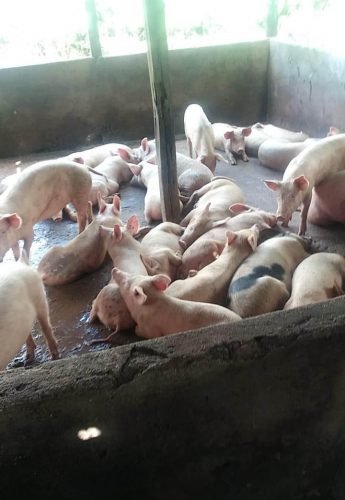Like hundreds of other Guyanese who have been operating modest business enterprises during 2020, Vasil Wood believes that the experience of having to do business in the destabilising environment of COVID-19 may well have taken him to a critical fork in his entrepreneurial road. The sixty-year-old pig farmer who lives and plies his trade at Good Intent, Mahaica, is almost certainly one of biggest operators in the industry on the East Coast corridor; and while not appearing to be someone given to needless complaining, he concedes that the year that has just gone by has been a testing one for him.
It was a year during which, simultaneously, the respective prices of feed and pork ‘took off’ in separate directions, so that in one fell swoop his overheads shot up and his returns dipped sharply.
It is not, Vasil says, a matter of “getting out of the business.” Giving up a pursuit which has enabled you to make a good living for more than thirty years is not the kind of decision that you can make at the proverbial drop of a hat. Still, when you are in business there are unpalatable realities that must be faced.

For Wood, 2020 has been a year of the harshest possible business realities.
It is not just a question of the anticipated increase in both volumes of sales and prices rising last year not materialising, but also a matter of the general elections imbroglio and the advent of COVID-19 creating a cocktail that precipitated a drastic slump in the trade. From around mid-year, Wood says, business simply came to a shuddering halt. It was not just a question of a drying up of visits by middlemen to his pig pens, but also a decline in smaller retail-size trade, a circumstance that may well have resulted from the self-imposed dietary restrictions of retail customers arising out of the spread of the pandemic.
This was a period during which Wood was saddled with pigs for which there was no market to speak of. Simultaneously he had little choice but to delve into his savings to purchase feed for the army of voracious eaters. On top of that, a significantly diminished market rendered his remaining handful of customers decidedly ‘picky’.
Wood believes that his entire year may well have been partially salvaged by a group of buyers from the interior between July and August. A somewhat greater measure of relief came between October and December when some of the customary seasonal ‘blessings’ began to materialise. Wood believes that the year-end ‘break’ was due largely to the improving compliance with the COVID-19 restrictions. In fact, he recalls that the market improved to the point where his December pork sales exceeded the level of December 2019. Still, fluctuating prices remain a problem and Wood says that some measure of state intervention might be needed though he appears unsure as to just how this should happen.
Pig farming, Wood says, has become increasingly demanding over the years. Prices often fluctuate wildly so that it has become almost impossible to predict the profit margins. We are in a “season,” he says, when the industry has fallen under the control of middlemen and restaurateurs whose profits are frequently greater than those of the pig breeder. He is concerned, too, about what he says is a scarcity of adequate veterinary services. He believes that the growth of the pig-rearing industry justifies an increase in the availability of qualified veterinarians. His own community is not served by a qualified vet and he remains concerned over the fact that many pig farmers administer medicines themselves, a practice that sometimes compromises the health of the animals.
Wood says that in circumstances where pork-eaters have become increasingly health conscious, there is, these days, an increasing demand for leaner meat. He says that this customer requirement necessitates dietary changes for the pigs that can increase operating costs. Setting aside rice bran, a staple in the diet of pigs, bread, fish, chow mein and biscuit, are also part of the diet. Feeding costs, he says, are further added to on account of the pigs’ voracious appetites. Rice bran prices can fluctuate wildly. During the paddy harvesting season the bran is sold at $400 per bag. In the out-of-crop periods the price is doubled.
While the National Agricultural Research & Extension Institute (NAREI) is the ‘point’ agency for the purchase of pigs for breeding, Wood says that the arrangement is unreliable. He says that he has tried, unsuccessfully, for more than four years to purchase pigs there. Accordingly, he has been forced to makes purchases from other farmers at significantly higher prices. Arising, perhaps, out of diet deficiencies, animals purchased from other farmers sometimes die inexplicably.
Most of his days are spent tending to pigs and he employs two persons who assist him with his day beginning at 2:30 am. So far, his sons have evinced a disinterest in taking over the reins of the business and Wood quite rightly fears that the farm’s days are numbered.






